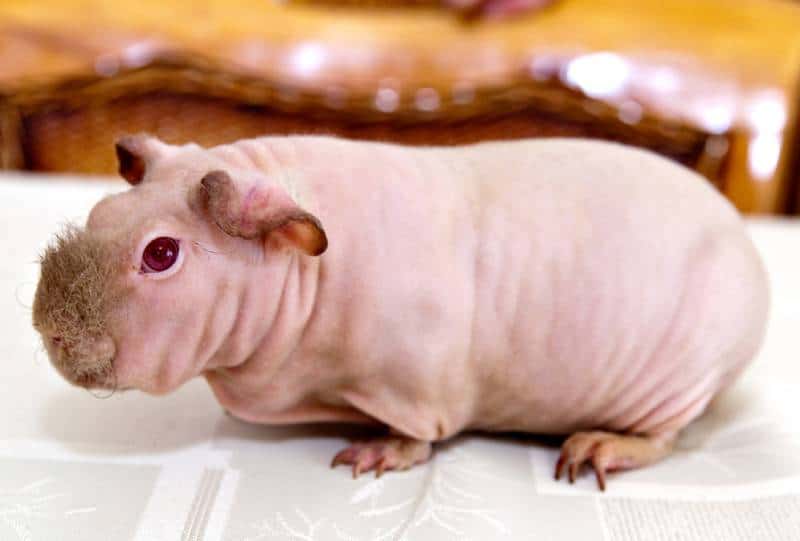GuineaPigWCG_P1569.jpg)
Though called a Hairless Guinea Pig, the Skinny Pig actually does have just a bit of hair!
The Skinny Pig is a very unusual, yet an increasingly popular breed of Guinea Pig. There are actually two types of Hairless Guinea Pig, this one and another called the Baldwin Guinea Pig. These nearly hairless critters have a funny way of winning the hearts of nearly all they come into contact with.
Skinny Pigs are as curious and mischievous as any other breed of Guinea pig, but some owners and breeders claim that they are more outgoing. They are quite playful, and they love attention.
Skinny Pigs do not require the brushing that other Guinea pigs need, but they do have certain special needs. They are more susceptible to injury than breeds with hair covering their bodies, and they are more sensitive to sunlight and temperature. They need a responsible owner to keep them happy and healthy.
Guinea Pig Information – Guinea Pig Care
Guide to a Happy Healthy Guinea Pig
- Kingdom: Animalia
- Phylum: Chordata
- Class: Mammalia
- Order: Rodentia
- Family: Caviidae
- Genus: Cavia
- Species: porcellus
Background:
The Skinny Pig’s origins go back to the late 1970s. The breed is the result of inbreeding in laboratory Guinea Pigs, which produced a genetic mutation that caused offspring to be born with virtually no hair. These animals were very unhealthy and had short life expectancies. But once in the hands of capable breeders, they were bred to healthier Guinea Pigs, and the health of the fledgling breed improved. They also developed a variety of colors and patterns.
Description:
The Skinny Pig has almost no hair on most of its body. The only exceptions are usually the nose and feet. Some have a small amount of hair in other areas such as the rump and shoulders. Its skin is somewhat wrinkled.
Color differences:
The Skinny pig can display any of the basic colors and patterns of the Guinea pig. This breed is not recognized by the ACBA or ARBA, so there is no set standard for coloring.
Keeping Guinea Pigs:
Be sure to provide your guinea pig with a good home and a proper diet. This will keep it happy and healthy and ensure a great pet for a long time.
Guinea pigs need plenty of exercise and they also love to play. You can let them outside or run around in the house for short periods of time under supervision. They love to explore and need at least one hour of supervised ‘floor time’ every day.
When picking up a guinea pig make sure you do not grab it only by its shoulders. Just keep in mind when picking your pet up to do it evenly. With your hands, support it’s entire body, and be careful not to drop it.
Guinea pigs are social creatures and will like to have a companion. They are great companions for children.
Take time to learn what your guinea pig needs, including:
- housing
- care and feeding
- social behaviors
- activies
- handling and training
- breeding guinea pigs
- baby guinea pigs.
Availability:
Skinny Pigs are becoming easier to find, but breeders may be hard to come by in some areas. Prices are higher than most other breeds, averaging $60 to $70 apiece
Guinea Pigs come in many varieties and are readily available at pet stores, shelters, and rescues. When looking to acquire a pet guinea pig make sure it is a healthy animal. A healthy guinea pig will have brilliant eyes, good sound teeth, and a healthy coat. Any age and either sex will make a good pet, however you should plan to get more than one as they are very social and do best with a companion. Get a same sex pair or you could end up having babies.
References
Pattinson, Emma Louise, “Origin of the Skinny Pig“, Copyright JACBA
“Skinny Pigs Information“, Guinea Pigs Club Malta, Copyright 2006-2008
“Skinny Pig Cavy“,The Rabbit and Cavy Directory
“Skinny Pig“,Wikipedia, Copyright 2008
Featured Image Credit: Anna Tronova, Shutterstock
